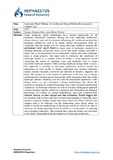| dc.contributor.author | Georgi, Neratzia Julia | |
| dc.contributor.author | Vissilia, Anna-Maria | |
| dc.date.accessioned | 2016-04-19T10:02:36Z | |
| dc.date.available | 2016-04-19T10:02:36Z | |
| dc.date.issued | 2015 | |
| dc.identifier.isbn | 978-9949-536-97-9 | |
| dc.identifier.uri | http://hdl.handle.net/11728/7508 | |
| dc.description.abstract | Today landscape digital technologies have become prerequisite for all landscape educational programs, altering the ways landscape architecture design schemes look, and by extension influencing the tra¬ditional methods that landscape architecture used to be taught. Digital representation skills are considered baseline design tool for young landscape architects entering the professional “new” world. However, many years of landscape experience in teaching landscape architecture studio proves that model making still holds a major role as an educational tool to understand, explore and create landscape space in studio projects. This paper aims to emphasize the importance of landscape models as a valuable source of mainly a visual approach toward conceiving the nature of landscape space and multitude ways to create successful landscape projects while teaching landscape design studio courses. Our approach to teaching in landscape architecture revolves around the importance of scale models to deeply understand and visualize landscape spatial concepts originally conceived and depicted in sketches, diagrams and plans. The medium of scale models is understood as the best way to deeply understand and visual¬ize spatial relationships while integrating them into studio landscape schemes. Realizing over the years this educational opportunity in the design studio, we have developed a design methodology that allows the students to integrate all acquired knowledge into a fully integrated professional experience. As land-scape educators we seek to develop a pedagogical approach towards enabling students effectively syn¬thesize their theoretical and technical knowledge. To evaluate our design methodology, data were compiled from students’ surveys, in class critiques and class evaluations. Results suggest that our students seem to have cultivated a deeper understanding of land¬scape space and have captured complex design ideas more effectively. More feedback data samples need to be collected over the forthcoming years during which we intend to enrich our methodology in the design courses in order to be able to reinforce our design approach based on models as a main means of cap¬turing and evaluating landscapes. This research aims stimulate debate and contribute to the further eman¬cipation and development of landscape architecture. | en_UK |
| dc.language.iso | en | en_UK |
| dc.relation.ispartofseries | Book of Proceedings, ECLAS Conference: Landscapes in Flux, Tartu, Estonia 20-23 September 2015; | |
| dc.rights | © Copyright ©2015 by the authors | en_UK |
| dc.rights.uri | http://creativecommons.org/licenses/by-nc-nd/4.0/ | en_UK |
| dc.subject | Landscape Design | en_UK |
| dc.subject | Education | en_UK |
| dc.subject | Space | en_UK |
| dc.subject | Representation | en_UK |
| dc.subject | Methodology | en_UK |
| dc.title | Landscape Model Making: An Archetypal Design Medium Reevaluated in a Digital Age | en_UK |
| dc.type | Book chapter | en_UK |


